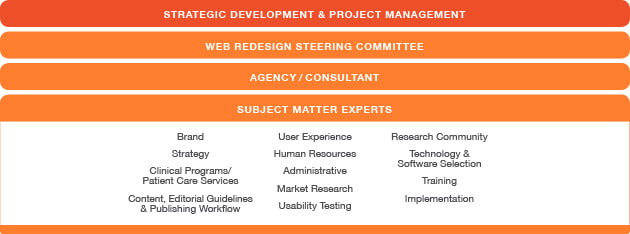Hospital website redesigns aren’t easy. First of all, there’s the internal politics. They seem to put the needs of individuals and department agendas over the needs of the entire organization. This complication seems to affect hospital website redesigns more than any other industry.
Second, and perhaps more difficult to address, is the simple fact that “Hospital employees are busy doing. Not documenting.” I got this insight from a trusted colleague and I never forgot it. One of the biggest struggles hospital marketers face is developing content that tells each clinical department and program’s unique story—and explains why their treatment is a patient’s best choice. And because hospital staff are busy saving lives this can make getting the information you’re looking for harder than with other organizations.
After leading the website redesign initiatives at three of Boston’s most well-known academic medical centers, I’d like to share a few valuable insights for your next hospital website redesign.
Step 1: Primary research & a digital roadmap
Make sure your new website supports your readers’ goals and your organization’s business objectives. The best way is to conduct small batches of primary research in the upfront portion of your project to create audience personas and journey maps. Just be sure you're looking beyond standard demographics (which are important too) and considering what motivates different patient audiences on a personal level. To learn more, check our recent article in eHealthcare Strategy & Trends.
With some great research insights in place, you can then shape your digital marketing strategy. Websites. Mobile apps. Search marketing. Online ads. Content marketing. There’s no end to the digital marketing tactics you could choose. Your roadmap, however, should align with the digital media your target audiences use most. For example, it makes no sense to spend time putting together a social media strategy if your audiences don’t use the social media space (Hint: they do). Download our eBook to explore four models to architect, design and build a consumer-centric hospital website that also delivers measurable ROI for your C-suite.
Step 2: Put down the wireframes and photoshop. Start with your brand.
Your brand is your most powerful differentiator. Lead with the heritage, the innovation, the culture and your people. These are unique. Taking the time upfront to define your hospital’s story will make a world of difference in a site that feels unique to you. See how Overlake Medical Center, Nantucket Hospital and Cooley Dickinson Hospital did just that.
Step 3: Define your content types
A hospital website can have over 3,000 pages of content. To help architect, write and get buy-in across the many different clinical, research and educational departments, organize the content by content types: Treatment programs, department overviews, physician profiles, fellowship programs, research programs, research labs, news articles, etc.
Here’s a list of hospital content types I find most helpful:

The earlier in the process you address your hospital website’s complex content, the better. Creating this structure will help your information architect begin the sitemap and wireframe process. It will help your stakeholders understand where their input is most required and, in the end, it will make faceted search and contextual content display possible across the website.
Step 4: Select a content management system (CMS) that supports a content type relationship model
Today’s CMS platforms are wonderful for supporting decentralized publishing governance models. However, one of the features that’s most often overlooked when selecting an enterprise-level CMS is its ability to share and relate content types to one another via tagging. For example, tagging eight content types in your CMS with “diabetes” gives hospital marketers the ability to build condition hub landing pages that a) patients can use to navigate to their treatment options and b) Google will index as content-rich and well-organized thematic pages. This diagram shows an example data structure.

Step 5: Consider your culture when making decisions about governance
Creating, maintaining and successfully publishing web content is no easy task. We often talk about “web authors” sprinkled throughout the organization who are asked to play one part copywriter, one part web designer and another part web programmer. And the promise of a CMS that allows anyone to copy and paste text into a WYSIWYG window and build vibrant and engaging web pages isn’t always as simple as it sounds.
That’s why developing a web governance model that supports this effort will be a critical component to your website’s success. My experiences have been that an organization will align with a model that best fits its culture.
For example, a large, decentralized organization’s website governance is, well, decentralized. And while it’s conceptually wonderful to let a thousand flowers bloom, the risk is that content and design begin to get outdated, one department’s content begins to look better than another’s, and functionality, design elements and content consistency begins to break down across the website. In contrast, when the model is completely centralized, the responsibility to produce meaningful content falls to the central marketing, communications and/or public affairs team. Problem is, these groups are often limited in size.
My recommendation is to envision what your new website will look like 3-5 years after you have launched knowing that your target audiences are not only grading your hospital website based on other hospital websites but also on the websites that they use most, for example, Google, Amazon, Facebook, Pinterest, news websites, etc. If this means building a hospital website that’s limited to 100 pages but enables you to provide up-to-date and relevant content created by a central bureau of web marketing content specialists it might be worth considering.
Finally, don't forget support and buy-in along the way
Embrace internal politics and acknowledge that a few well-staffed committees can actually be your best friend. I have found it useful to develop committees to select an agency partner, committees for large departments like Medicine and Surgery (that have many divisions), senior leadership stakeholder committees and sub-committee working groups with subject matter experts including research, IS, Development and Human Resources. View my committee matrix below.

This approach ensures that your initiative will run smoother; plus you’ll receive the trust and feedback you’re desperately in need of from departmental and divisional chiefs and chairs.



